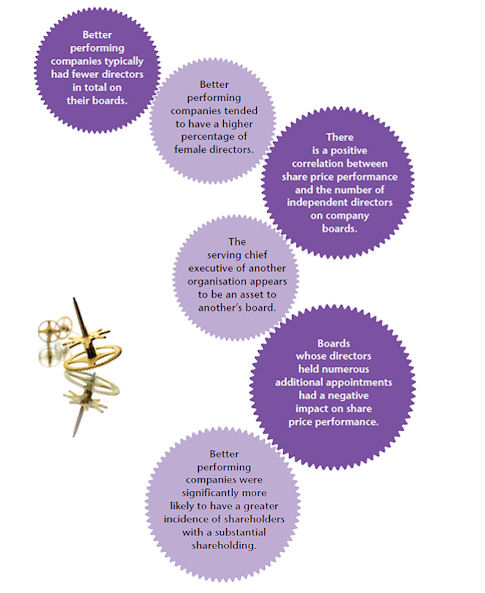The size and shape of a board play a tangible part in the success, or otherwise, of an organisation according to recent research from Eversheds.
Who should be on the board? International law firm Eversheds' recent research into the composition of management boards of top businesses highlights the ideal make up of boardrooms of successful firms. Eversheds chairman John Heaps summarises key findings.
The Eversheds Board Report conclusions:

While the past few years have been unpleasant, they have also been a proving ground for businesses. There are lessons to be learnt across all sectors by looking at what the successful businesses did well and where the failing businesses went wrong. In addition to undertaking empirical research into the correlation between board composition and share-price performance, we wanted to ask the senior managers themselves what they thought mattered most in terms of the recent performance of their board and whether there was an optimal way of structuring boards to manage risk and increase effectiveness.
.jpg)
Here are the key elements of a successful board:
Smaller boards
Both the data analysis and interviews with directors indicated that better performing companies had fewer directors in total on their boards. This was true for Hong Kong, the US and Europe in particular. Boards in the sample group had between six and 32 directors, with European companies having the highest number of directors at 18.7 on average. In the Asia region, a cluster analysis approach to the data showed that companies in Asia-Pacific with larger boards significantly under-performed compared to companies with smaller boards. Directors were largely unsurprised that companies with smaller boards performed better. They told us that the benefits of smaller boards were (in descending order of mentions): greater focus on the key issues; better management from the chairman; quicker decision making; and better overall dynamics between board members.
Female directors
Better performing companies also tended to have a higher percentage of female directors – a finding which was borne out by both the statistical and the cluster analysis of the quantitative data. This finding was particularly strong for banks and UK companies. However, only 55 per cent of directors interviewed positively thought that diversity for its own sake was beneficial for board and company performance and only half that number were directly in favour of positive action to place more women onto boards.
Independent directors
Overall, there is a positive connection between share-price performance and the number of independent directors on company boards. The finding is stronger in certain regions such as Asia-Pacific, and with industry sectors such as banking and finance. The directors interviewed marginally preferred independence to experience when asked to make a choice. However, a majority (67 per cent) of directors said that both were equally important when putting a board together. However, the share price performance of companies in the sample group showed no correlation with the numbers of board directors with “relevant industry experience“, although a positive relationship was evident in the property, insurance, industrial goods and chemicals and utilities and telecoms sectors. Of directors interviewed, 90 per cent did not believe that a lack of “relevant industry experience” on bank boards had any relationship to the financial crisis. Nor did they believe that the financial crisis was caused by having too many independent directors.

Methodology
There were two main strands to the project conducted by independent research company, RSG Consulting Limited. First of all, the research examined the board composition and share price performance of 241 of the leading global companies between January 2007 and December 2009. An international approach was taken, choosing companies headquartered in the UK, continental Europe, the USA and the Asia-Pacific region.
This analysis was complemented with in-depth interviews with 50 directors from a cross section of the 241 companies involved. They were asked for their opinions on board role, board composition and board effectiveness. Findings were analysed both by region and industry sector.
PR Masterclass: The Intersection of PR and GEO
Join PRmoment for a Masterclass featuring 10 of the industry’s foremost experts. You will walk away with a clear, actionable strategy for adapting your content to an AI-first search environment.
Taking place on Wednesday 25th February in London, both virtual and in person tickets are available.
If you enjoyed this article, sign up for free to our twice weekly editorial alert.
We have six email alerts in total - covering ESG, internal comms, PR jobs and events. Enter your email address below to find out more:









